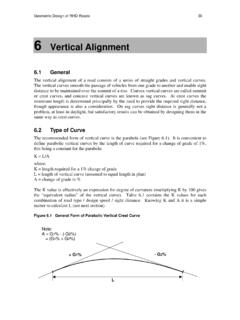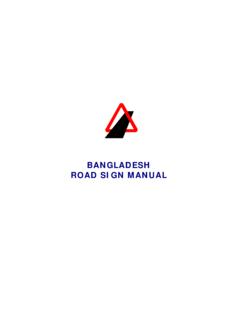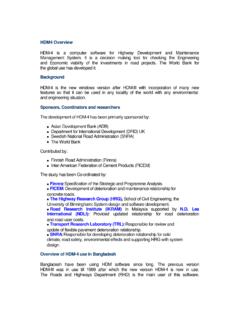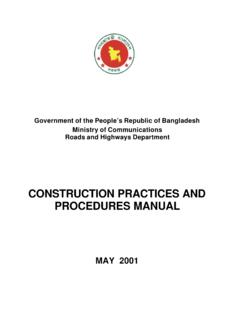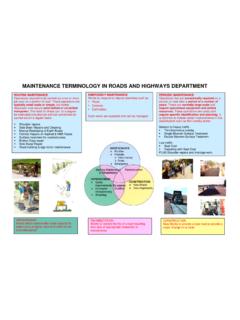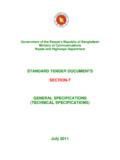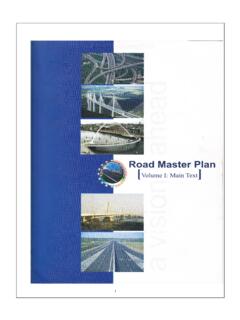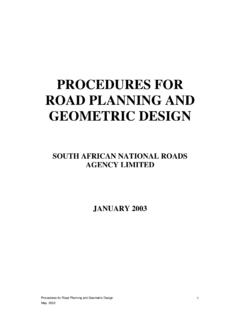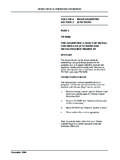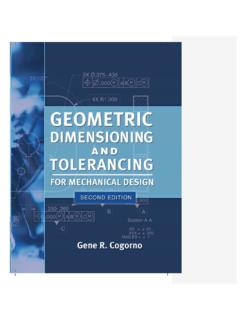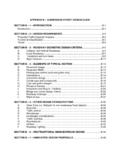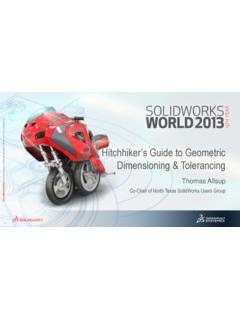Transcription of Geometric Design Standards for Roads & …
1 Government of the People s Republic of BangladeshMinistry of CommunicationsRoads and Railways DivisionGeometric Design StandardsforRoads & Highways DepartmentDraft Version 4 October 2000 Geometric Design of RHD Roads Vers. 4 of this Materials and Standards .. Types and Volume and Design Design Type and Design Trial the Trial Alignment Against Design Speed a Detailed Consistency the , Environment, Land and the Economic and Type for NMVs and Bays and Stopping Calming Through Towns and and Vertical at Bridges and the Curve Design of RHD Roads Vers. 4 of the Curve Driver s the road to the Safer Accidents and Their Design of RHD Roads Vers.
2 4 iiiGlossaryAADT Annual average daily traffic crossfall (on a horizontal curve) Crossfall that tilts away from the centre of thecurve and thus adds to the amount of friction needed to stop a vehicle from moving sidewaysas it traverses the of rotation The line along which the carriageway is rotated on curves in order todevelop superelevation it is recommended that this be the inner edge of the That part of the road for use by moving traffic, and normally divided intotraffic zone A strip of ground alongside the road that is kept free of hazardous curve A convex vertical curve with a peak (summit).
3 Crossfall The transverse slope that helps the carriageway to drain The highest point on the cross-section of the Type One of six standard road types (cross-sections). Each Type is associated witha specific traffic volume Year (DY) The year for which the road is designed. It is usually the 10th year afterthe road is opened to Speed The speed of traffic for which the road or road section is designed. This istaken to be the 85th percentile speed of the traffic on the carriageway A road having two separate carriageways for travel in A pedestrian pathway alongside a alignment The direction and course of the road in plan view comprisingtangents and value The ratio of the minimum length of vertical curve in metres to the algebraicdifference in percentage gradients adjoining the curve.
4 It is effectively an expression fordegree of curvature and is the main Design parameter for vertical of Service A road performance classification used in the highway The strip of ground or structure between the two carriageways of a dualcarriageway Motor Non-motorised vehicle, cycle rickshaws, bicycles, hand car unit (PCU) A measure of traffic flow which takes account of the time /spacetaken up by different vehicle types. Each type of vehicle has a passenger car unit equivalent for cycle rickshaws it is (see Table ). Geometric Design of RHD Roads Vers. 4 ivkPavement That part of the road designed and constructed to withstand the weight A value below which the given percentage of values fall.
5 If the 85th percentilespeed is 70km/h it means that 85% of vehicles were travelling at a speed of less than 70 Classification The official classification of RHD Roads based loosely on road function(National, Regional, and Feeder).RHD Roads and Highways road Materials and Standards curve A concave vertical That strip of ground along the edge of the carriageway that is for emergencystopping and for general use by slow-moving vehicles, NMVs and distance The distance ahead that a driver must be able to see in order to safely carryout a manoeuvre. There are three sight distances referred to here: the Stopping SightDistance (SSD), the Overtaking Sight Distance (OSD), and the Intermediate SightDistance (ISD).
6 Superelevation The inward tilt given to the cross-section of a carriageway throughout thelength of a horizontal curve to reduce the frictional requirements between the vehicles tyresand the road A straight section of A hot-melt plastic used to form durable road calming Self-enforcing engineering measures that reduce the speed of curve A curve in which the radius changes continuously along its length. Atransition curve is often used for the purpose of connecting a straight with a circular The grassed strip at the edges of the road alignment The direction and course of the road in road users Pedestrians, cyclists, cycle rickshaw riders, autorickshaw riders, Design of RHD of this ManualThis manual aims to promote good, consistent practice in the Geometric Design of the Roadsand Highways department s Roads .
7 It has been written for RHD staff and their consultantsand assumes that they have some knowledge of highway Design . All RHD road projectsshould be designed in accordance with the Design approach, Standards , assumptions, etc., thatare set out in this manual. It is hoped that this will lead to better designed Roads Roads thatare operationally effective, economic to build and maintain, and are as safe as we can affordto make them. A simple manual like this cannot cover all possible circumstances, and there isnothing to stop designers from doing something different if they can make a good case for Materials and Standards Study, 1994 The Standards set out in this manual are mostly derived from RHD s road Materials andStandards Study (RMSS).
8 Readers who are interested in how the Standards were derivedshould refer to the RMSS report, principally Vol. V11A Development of Geometric DesignStandards . ApproachGeometric Design of Roads is a complex task. Getting to a satisfactory Design that meets allthe constraints calls for much skill and experience. There is often a lot of trial and error, andthe final Design is likely to be a compromise. The Standards in the manual are definedprecisely but there is some scope for modifying them in order to achieve an appropriatedesign for a specific problem. It is hoped that by following the Design process set out in thismanual the task will be made of the basic assumptions is that driver behaviour can be influenced by the appearance ofthe road and the road environment.
9 It is vital that everything be done to give drivers clearclues and messages about how they should negotiate each section of road and, particularly,how fast they should manual makes extensive use of material from two Design guides: A guide to geometricdesign , Overseas road Note 6, Transport Research Laboratory, UK, 1988, and Rural RoadDesign , Austroads, 1989. The co-operation of TRL and Austroads in permitting the use oftheir work is gratefully acknowledged. A full list of references appears at the end of Design of RHD Roads2 Design Types and StandardsThe Geometric Design Standards are summarised in Table (Cross-Sections) and Table (Speed Related Design Parameters).
10 There are six standard cross-sections ( Design Type 1 to6) each of which is suitable for a specific range of traffic volumes. The traffic volume levelsat which the cross-sections change have been selected largely on the basis of economicanalysis, and must be treated as approximate, because of the many uncertainties. The DesignYear is normally the 10th year after the road is open to traffic. However, the Design Typeshould not be more than one Type higher than that for the traffic volume in the year the Design Standards relate to horizontal and vertical curves, and these are largely derivedfrom the Design speeds and sight distances.
